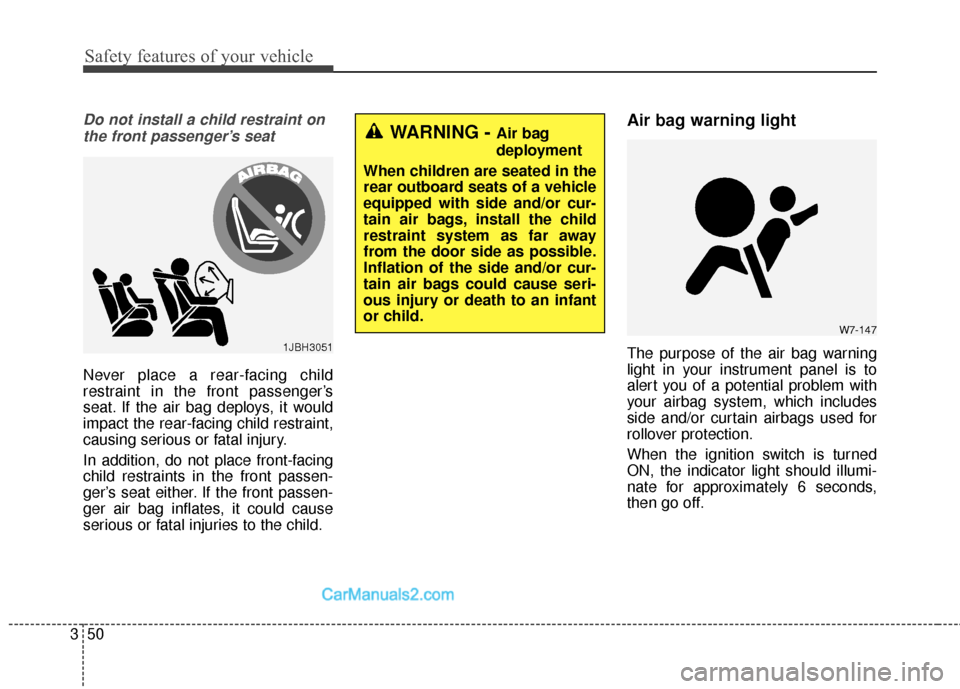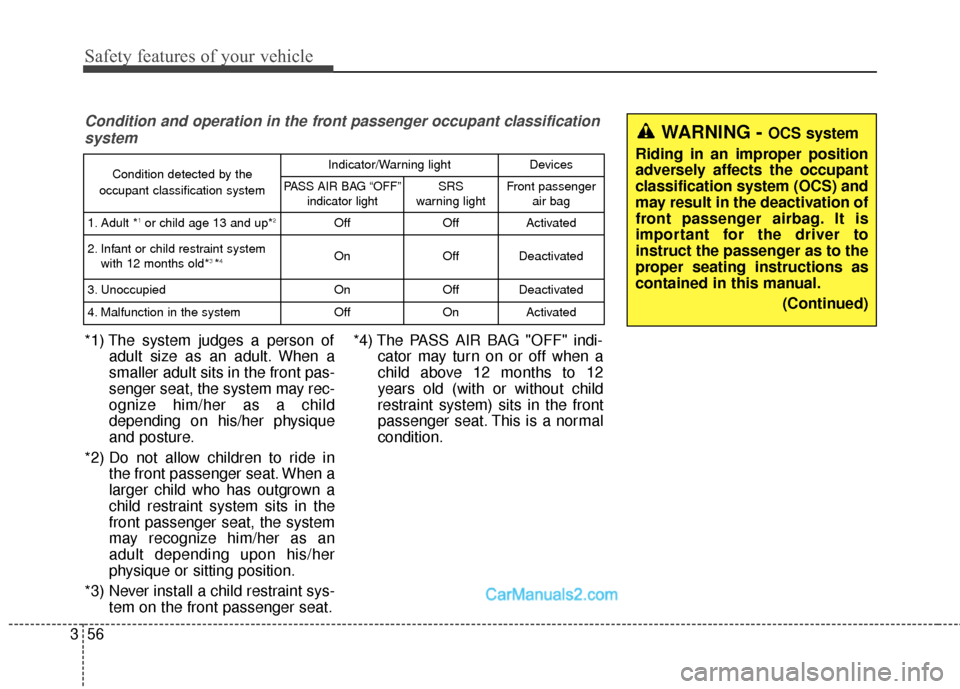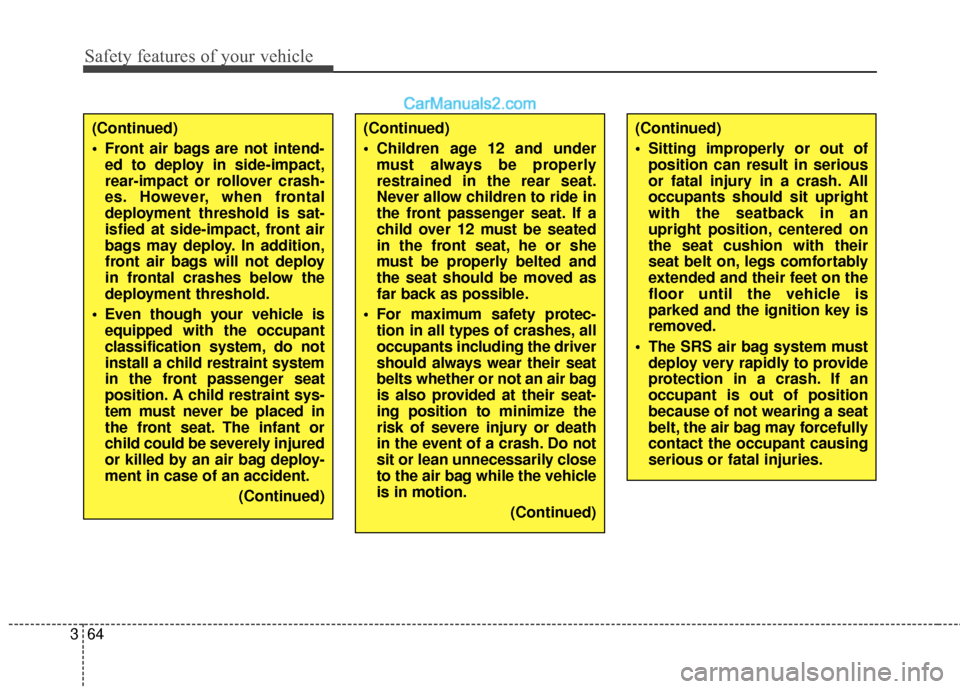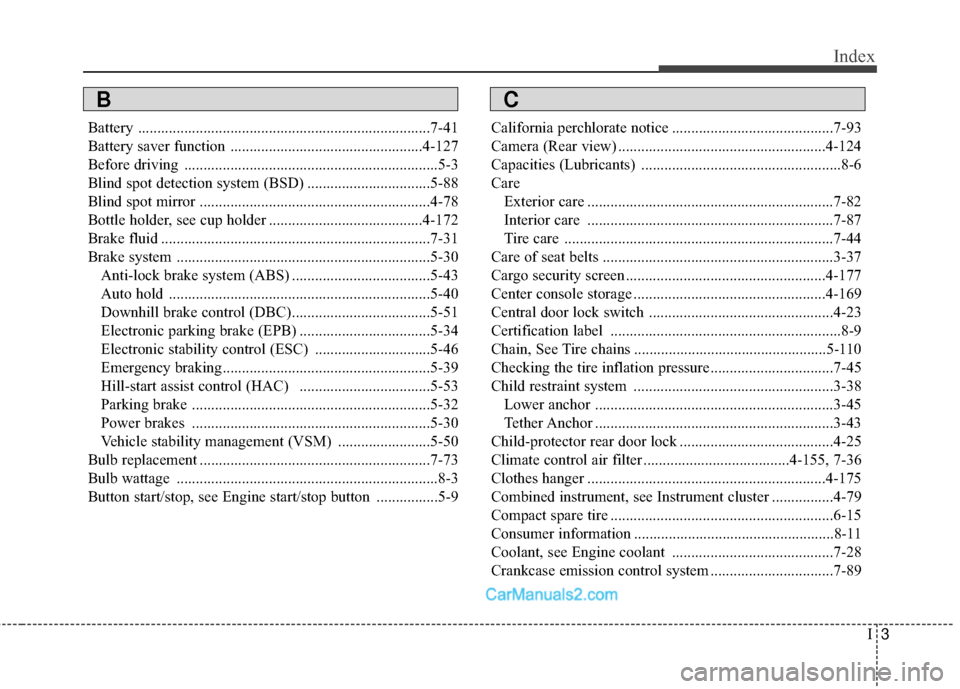2017 Hyundai Santa Fe Sport child restraint
[x] Cancel search: child restraintPage 68 of 614

Safety features of your vehicle
46
3
LATCH anchors have been provided
in your vehicle. The LATCH anchors
are located in the left and right out-
board rear seating positions. Their
locations are shown in the illustration.
There is no LATCH anchor provided
for the center rear seating position.
The LATCH anchors are located
between the seatback and the seat
cushion of the rear seat left and right
outboard seating positions.
Follow the child seat manufacturer’s
instructions to properly install child
restraint seats with LATCH or
LATCH-compatible attachments.
Once you have installed the LATCH
child restraint, assure that the seat is
properly attached to the LATCH and
tether anchors. Also, test the child restraint seat
before you place the child in it. Tilt
the seat from side to side. Also try to
tug the seat forward. Check to see if
the anchors hold the seat in place.
✽ ✽
NOTICE
The recommended weight for the
LATCH system is under 65 lb
(30 kg).
How to calculate the child restraint
weight :
Child restraint weight =
65 lb (30 kg) - Child weightWARNING
If the child restraint is not
anchored properly, the risk of a
child being seriously injured or
killed in a collision greatly
increases.
WARNING - LATCH lower
anchors
LATCH lower anchors are only
to be used with the left and right
rear outboard seating positions.
Never attempt to attach a LATCH
equipped seat in the center
seating position. You may dam-
age the anchors or the anchors
may fail and break in a collision.
CAUTION
Do not allow the rear seat belt webbing to get scratched orpinched by the child-seat latchand LATCH anchor during theinstallation.
WARNING
Do not place anything around
the lower anchors. Also make
sure that the seat belt is not
caught in the lower anchors.
Page 72 of 614

Safety features of your vehicle
50
3
Do not install a child restraint on
the front passenger’s seat
Never place a rear-facing child
restraint in the front passenger’s
seat. If the air bag deploys, it would
impact the rear-facing child restraint,
causing serious or fatal injury.
In addition, do not place front-facing
child restraints in the front passen-
ger’s seat either. If the front passen-
ger air bag inflates, it could cause
serious or fatal injuries to the child.
Air bag warning light
The purpose of the air bag warning
light in your instrument panel is to
alert you of a potential problem with
your airbag system, which includes
side and/or curtain airbags used for
rollover protection.
When the ignition switch is turned
ON, the indicator light should illumi-
nate for approximately 6 seconds,
then go off.
W7-147
WARNING - Air bag
deployment
When children are seated in the
rear outboard seats of a vehicle
equipped with side and/or cur-
tain air bags, install the child
restraint system as far away
from the door side as possible.
Inflation of the side and/or cur-
tain air bags could cause seri-
ous injury or death to an infant
or child.
1JBH3051
Page 78 of 614

Safety features of your vehicle
56
3
Condition and operation in the front passenger occupant classification
system
*1) The system judges a person of adult size as an adult. When a
smaller adult sits in the front pas-
senger seat, the system may rec-
ognize him/her as a child
depending on his/her physique
and posture.
*2) Do not allow children to ride in the front passenger seat. When a
larger child who has outgrown a
child restraint system sits in the
front passenger seat, the system
may recognize him/her as an
adult depending upon his/her
physique or sitting position.
*3) Never install a child restraint sys- tem on the front passenger seat. *4) The PASS AIR BAG "OFF" indi-
cator may turn on or off when a
child above 12 months to 12
years old (with or without child
restraint system) sits in the front
passenger seat. This is a normal
condition.
WARNING - OCS system
Riding in an improper position
adversely affects the occupant
classification system (OCS) and
may result in the deactivation of
front passenger airbag. It is
important for the driver to
instruct the passenger as to the
proper seating instructions as
contained in this manual. (Continued)
Condition detected by the
occupant classification systemIndicator/Warning lightDevices
PASS AIR BAG “OFF” indicator lightSRS
warning lightFront passenger air bag
1. Adult *1or child age 13 and up*2OffOffActivated
2. Infant or child restraint system with 12 months old*3 *4OnOffDeactivated
3. Unoccupied OnOffDeactivated
4. Malfunction in the systemOffOnActivated
Page 81 of 614

359
Safety features of your vehicle
WARNING
Even though your vehicle isequipped with the occupant
classification system, never
install a child restraint system
in the front passenger's seat.
A deploying air bag can force-
fully strike a child resulting in
serious injuries or death. Any
child age 12 and under should
ride in the rear seat. Children
too large for child restraints
should use the available
lap/shoulder belts. No matter
what type of crash, children of
all ages are safer when
restrained in the rear seat.
(Continued)
(Continued)
If the PASS AIR BAG "OFF"indicator is illuminated when
the front passenger's seat is
occupied by an adult and
he/she sits properly (sitting
upright with the seatback in
an upright position, centered
on the seat cushion with their
seat belt on, legs comfortably
extended and their feet on the
floor), have that person sit in
the rear seat.
Do not modify or replace the front passenger seat. Don't
place anything on or attach
anything such as a blanket or
seat heater to the front pas-
senger seat. This can adverse-
ly affect the occupant classifi-
cation system.
Do not sit on sharp objects such as tools when occupying
the front passenger seat. This
can adversely affect the occu-
pant classification system.
(Continued)(Continued)
Do not use accessory seatcovers on the front seats.
Accident statistics show that children are safer if they are
restrained in the rear, as
opposed to the front seat. It is
recommended that child
restraints be secured in a rear
seat, including an infant riding
in a rear-facing infant seat, a
child riding in a forward-fac-
ing child seat and an older
child riding in a booster seat.
Air bags can only be used once – have an authorized
HYUNDAI dealer replace the
air bag immediately after
deployment.
(Continued)
Page 84 of 614

Safety features of your vehicle
62
3
✽
✽
NOTICE
• Be sure to read information about
the SRS on the labels provided on
the sun visor.
• Advanced air bags are combined with pre-tensioner seat belts to
help provide enhanced occupant
protection in frontal crashes.
Front air bags are not intended to
deploy in collisions in which pro-
tection can be provided by the pre-
tensioner seat belt.
WARNING
If you are considering modifica-
tion of your vehicle due to a dis-
ability, please contact the
Hyundai Customer Assistance
Center at 1-800-633-5151.
WARNING
Do not place any objects under-
neath the front seats as they
could interfere with the occu-
pant classification system.
WARNING
Always use seat belts and child
restraints – every trip, every
time, everyone! Air bags inflate
with considerable force and in
the blink of an eye. Seat belts
help keep occupants in proper
position to obtain maximum
benefit from the air bag. Even
with advanced air bags, improp-
erly and unbelted occupants
can be severely injured when
the air bag inflates.
Always follow the precautions
about seat belts, air bags and
occupant safety contained in this
manual. To reduce the chance of
serious or fatal injuries and
receive the maximum safety ben-
efit from your restraint system:
Never place a child in any child
or booster seat in the front seat.
ABC – Always Buckle Children in the back seat. It is the safest
place for children of any age
to ride.
(Continued)
Page 86 of 614

Safety features of your vehicle
64
3
(Continued)
Sitting improperly or out of
position can result in serious
or fatal injury in a crash. All
occupants should sit upright
with the seatback in an
upright position, centered on
the seat cushion with their
seat belt on, legs comfortably
extended and their feet on the
floor until the vehicle is
parked and the ignition key is
removed.
The SRS air bag system must deploy very rapidly to provide
protection in a crash. If an
occupant is out of position
because of not wearing a seat
belt, the air bag may forcefully
contact the occupant causing
serious or fatal injuries.(Continued)
Front air bags are not intend-ed to deploy in side-impact,
rear-impact or rollover crash-
es. However, when frontal
deployment threshold is sat-
isfied at side-impact, front air
bags may deploy. In addition,
front air bags will not deploy
in frontal crashes below the
deployment threshold.
Even though your vehicle is equipped with the occupant
classification system, do not
install a child restraint system
in the front passenger seat
position. A child restraint sys-
tem must never be placed in
the front seat. The infant or
child could be severely injured
or killed by an air bag deploy-
ment in case of an accident.
(Continued)(Continued)
Children age 12 and undermust always be properly
restrained in the rear seat.
Never allow children to ride in
the front passenger seat. If a
child over 12 must be seated
in the front seat, he or she
must be properly belted and
the seat should be moved as
far back as possible.
For maximum safety protec- tion in all types of crashes, all
occupants including the driver
should always wear their seat
belts whether or not an air bag
is also provided at their seat-
ing position to minimize the
risk of severe injury or death
in the event of a crash. Do not
sit or lean unnecessarily close
to the air bag while the vehicle
is in motion.
(Continued)
Page 89 of 614

367
Safety features of your vehicle
They are designed to help protect
occupants in certain side impacts
and to help prevent them from eject-
ing out of the vehicle as a result of a
rollover, especially when the seat-
belts are also in use.
to deploy during certain side
impact collisions, depending on the
crash severity, angle, speed and
point of impact. However, when
side deployment threshold is satis-
fied at front-impact, curtain air
bags may deploy.
The curtain air bags may deploy on the side of the impact.
Also, the curtain air bags on both sides of the vehicle will deploy in
certain rollover situations.
The curtain air bags are not designed to deploy in all side
impact or rollover situations.(Continued)
Do not allow the passengersto lean their heads or bodies
onto doors, put their arms on
the doors, stretch their arms
out of the window, or place
objects between the doors
and passengers when they are
seated on seats equipped with
side and/or curtain air bags.
Never try to open or repair any components of the side cur-
tain air bag system. This
should only be done by an
authorized HYUNDAI dealer.
Failure to follow the above
instructions can result in injury
or death to the vehicle occu-
pants in an accident.WARNING
In order for side and curtain air bags to provide the best
protection, front seat occu-
pants and outboard rear occu-
pants should sit in an upright
position with the seat belts
properly fastened.
Importantly, children should
sit in a proper child restraint
system in the rear seat.
When children are seated in the rear outboard seats, they
must be seated in the proper
child restraint system. Make
sure to put the child restraint
system as far away from the
door side as possible, and
secure the child restraint sys-
tem in a locked position.
(Continued)
Page 605 of 614

I3
Index
Battery ........................................................................\
....7-41
Battery saver function ..................................................4-127
Before driving ..................................................................5-3
Blind spot detection system (BSD) ................................5-88
Blind spot mirror ............................................................4-78
Bottle holder, see cup holder ........................................4-172
Brake fluid ......................................................................7-\
31
Brake system ..................................................................5-30Anti-lock brake system (ABS) ....................................5-43
Auto hold ....................................................................5-40\
Downhill brake control (DBC)....................................5-51
Electronic parking brake (EPB) ..................................5-34
Electronic stability control (ESC) ..............................5-46
Emergency braking......................................................5-39
Hill-start assist control (HAC) ..................................5-53
Parking brake ..............................................................5-32
Power brakes ..............................................................5-30
Vehicle stability management (VSM) ........................5-50
Bulb replacement ............................................................7-73
Bulb wattage ....................................................................8-3
Button start/stop, see Engine start/stop button ................5-9 California perchlorate notice ..........................................7-93
Camera (Rear view) ......................................................4-124
Capacities (Lubricants) ....................................................8-6
Care
Exterior care ................................................................7-82
Interior care ................................................................7-87
Tire care ......................................................................7-\
44
Care of seat belts ............................................................3-37
Cargo security screen ....................................................4-177
Center console storage ..................................................4-169
Central door lock switch ................................................4-23
Certification label ............................................................8-9
Chain, See Tire chains ..................................................5-110
Checking the tire inflation pressure ................................7-45
Child restraint system ....................................................3-38 Lower anchor ..............................................................3-45
Tether Anchor ..............................................................3-43
Child-protector rear door lock ........................................4-25
Climate control air filter ......................................4-155, 7-36
Clothes hanger ..............................................................4-175
Combined instrument, see Instrument cluster ................4-79
Compact spare tire ..........................................................6-15
Consumer information ....................................................8-11
Coolant, see Engine coolant ..........................................7-28
Crankcase emission control system ................................7-89
BC